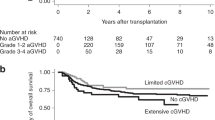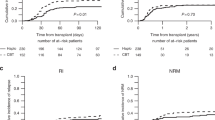Abstract
This study aimed to assess the impact of antithymocyte globulin (ATG) on patient outcome in a retrospective series of 91 patients (median age: 12 years) who underwent unrelated single-unit cord blood transplantation (allo-CBT) following a myeloablative conditioning regimen. Cord blood units were HLA-matched (6/6, n=18; 21%), one-Ag mismatched (n=30, 35%) or two-Ag mismatched (n=38; 44%). In this series, the OS, nonrelapse mortality (NRM) and cumulative incidence of relapse were 47±6%, 23±4% and 48±5%, respectively. Among 46 patients who received ATG as part of the conditioning regimen, the incidence of acute and chronic GVHD was lower than that in the group of 45 patients who did not receive ATG (20% vs 43%; P=0.03). However, multivariate statistical analysis revealed that the ATG use was associated with decreased OS and EFS rates and a high incidence of NRM (hazard ratio (HR)=1.99, 95% confidence interval (CI): 1.11–3.59, P=0.02), (HR=1.83, 95% CI: 1.08–3.10, P=0.02) and (HR=2.54, 95% CI: 1.03–6.26, P=0.04), respectively. Therefore, our results do not support the use of ATG as part of a myeloablative-conditioning regimen before single-unit allo-CBT in younger patients with hematological malignancies.
This is a preview of subscription content, access via your institution
Access options
Subscribe to this journal
Receive 12 print issues and online access
$259.00 per year
only $21.58 per issue
Buy this article
- Purchase on Springer Link
- Instant access to full article PDF
Prices may be subject to local taxes which are calculated during checkout

Similar content being viewed by others
References
Kurtzberg J, Laughlin M, Graham ML, Smith C, Olson JF, Halperin EC et al. Placental blood as a source of hematopoietic stem cells for transplantation into unrelated recipients. N Engl J Med 1996; 335: 157–166.
Rocha V, Labopin M, Sanz G, Arcese W, Schwerdtfeger R, Bosi A et al. Transplants of umbilical-cord blood or bone marrow from unrelated donors in adults with acute leukemia. N Engl J Med 2004; 351: 2276–2285.
Laughlin MJ, Eapen M, Rubinstein P, Wagner JE, Zhang M-J, Champlin RE et al. Outcomes after transplantation of cord blood or bone marrow from unrelated donors in adults with leukemia. N Engl J Med 2004; 351: 2265–2275.
Barker JN, Scaradavou A, Stevens CE . Combined effect of total nucleated cell dose and HLA match on transplantation outcome in 1061 cord blood recipients with hematologic malignancies. Blood 2010; 115: 1843–1849.
Gluckman E, Broxmeyer HA, Auerbach AD, Friedman HS, Douglas GW, Devergie A et al. Hematopoietic reconstitution in a patient with Fanconi’s anemia by means of umbilical-cord blood from an HLA-identical sibling. N Engl J Med 1989; 321: 1174–1178.
Rodrigues CA, Sanz G, Brunstein CG, Sanz J, Wagner JE, Renaud M et al. Analysis of risk factors for outcomes after unrelated cord blood transplantation in adults with lymphoid malignancies: a study by the Eurocord-Netcord and lymphoma working party of the European group for blood and marrow transplantation. J Clin Oncol 2009; 27: 256–263.
Barker JN, Weisdorf DJ, DeFor TE, Blazar BR, Miller JS, Wagner JE . Rapid and complete donor chimerism in adult recipients of unrelated donor umbilical cord blood transplantation after reduced-intensity conditioning. Blood 2003; 102: 1915–1919.
Broxmeyer HE, Douglas GW, Hangoc G, Cooper S, Bard J, English D et al. Human umbilical cord blood as a potential source of transplantable hematopoietic stem/progenitor cells. Proc Natl Acad Sci USA 1989; 86: 3828–3832.
Komanduri KV, St John LS, de Lima M, McMannis J, Rosinski S, McNiece I et al. Delayed immune reconstitution after cord blood transplantation is characterized by impaired thymopoiesis and late memory T-cell skewing. Blood 2007; 110: 4543–4551.
Mohty M . Mechanisms of action of antithymocyte globulin: T-cell depletion and beyond. Leukemia 2007; 21: 1387–1394.
Bacigalupo A, Lamparelli T, Bruzzi P, Guidi S, Alessandrino PE, di Bartolomeo P et al. Antithymocyte globulin for graft-versus-host disease prophylaxis in transplants from unrelated donors: 2 randomized studies from Gruppo Italiano Trapianti Midollo Osseo (GITMO). Blood 2001; 98: 2942–2947.
Mohty M, Gaugler B . Advances in umbilical cord transplantation: the role of thymoglobulin/ATG in cord blood transplantation. Best Pract Res Clin Haematol 2010; 23: 275–282.
Gooley TA, Leisenring W, Crowley J, Storer BE . Estimation of failure probabilities in the presence of competing risks: new representations of old estimators. Stat Med 1999; 18: 695–706.
Cox DR . Regression models and life-tables. J R Stat Soc B 1972; 34: 187–220.
Sanz J, Boluda JCH, Martín C, González M, Ferrá C, Serrano D et al. Single-unit umbilical cord blood transplantation from unrelated donors in patients with hematological malignancy using busulfan, thiotepa, fludarabine and ATG as myeloablative conditioning regimen. Bone Marrow Transplant 2012; 47: 1287–1293.
Ciurea SO, Saliba RM, Hamerschlak N, Karduss Aurueta AJ, Bassett R, Fernandez-Vina M et al. Fludarabine, melphalan, thiotepa and anti-thymocyte globulin conditioning for unrelated cord blood transplant. Leuk Lymphoma 2012; 53: 901–906.
Barker JN, Weisdorf DJ, DeFor TE, Blazar BR, McGlave PB, Miller JS et al. Transplantation of 2 partially HLA-matched umbilical cord blood units to enhance engraftment in adults with hematologic malignancy. Blood 2005; 105: 1343–1347.
Mohty M, Labopin M, Balère ML, Socié G, Milpied N, Tabrizi R et al. Antithymocyte globulins and chronic graft-vs-host disease after myeloablative allogeneic stem cell transplantation from HLA-matched unrelated donors: a report from the Sociéte Française de Greffe de Moelle et de Thérapie Cellulaire. Leukemia 2010; 24: 1867–1874.
Blaise D, Tabrizi R, Boher J-M, Le Corroller-Soriano A-G, Bay J-O, Fegueux N et al. Randomized study of 2 reduced-intensity conditioning strategies for human leukocyte antigen-matched, related allogeneic peripheral blood stem cell transplantation: prospective clinical and socioeconomic evaluation. Cancer 2013; 119: 602–611.
Finke J, Bethge WA, Schmoor C, Ottinger HD, Stelljes M, Zander AR et al. Standard graft-versus-host disease prophylaxis with or without anti-T-cell globulin in haematopoietic cell transplantation from matched unrelated donors: a randomised, open-label, multicentre phase 3 trial. Lancet Oncol 2009; 10: 855–864.
Soiffer RJ, Lerademacher J, Ho V, Kan F, Artz A, Champlin RE et al. Impact of immune modulation with anti-T-cell antibodies on the outcome of reduced-intensity allogeneic hematopoietic stem cell transplantation for hematologic malignancies. Blood 2011; 117: 6963–6970.
Bacigalupo A, Lamparelli T, Barisione G, Bruzzi P, Guidi S, Alessandrino PE et al. Thymoglobulin prevents chronic graft-versus-host disease, chronic lung dysfunction, and late transplant-related mortality: long-term follow-up of a randomized trial in patients undergoing unrelated donor transplantation. Biol Blood Marrow Transplant. 2006; 12: 560–565.
Laughlin MJ, Barker J, Bambach B, Koc ON, Rizzieri DA, Wagner JE et al. Hematopoietic engraftment and survival in adult recipients of umbilical-cord blood from unrelated donors. N Engl J Med 2001; 344: 1815–1822.
Migliaccio AR, Adamson JW, Stevens CE, Dobrila NL, Carrier CM, Rubinstein P . Cell dose and speed of engraftment in placental/umbilical cord blood transplantation: graft progenitor cell content is a better predictor than nucleated cell quantity. Blood 2000; 96: 2717–2722.
Gluckman E, Rocha V, Chevret S . Results of unrelated umbilical cord blood hematopoietic stem cell transplantation. Rev Clin Exp Hematol 2001; 5: 87–99.
Gluckman E, Rocha V, Arcese W, Michel G, Sanz G, Chan K-W et al. Factors associated with outcomes of unrelated cord blood transplant: guidelines for donor choice. Exp Hematol 2004; 32: 397–407.
Rubinstein P, Carrier C, Scaradavou A, Kurtzberg J, Adamson J, Migliaccio AR et al. Outcomes among 562 recipients of placental-blood transplants from unrelated donors. N Engl J Med 1998; 339: 1565–1577.
Mohty M, Bay J-O, Faucher C, Choufi B, Bilger K, Tournilhac O et al. Graft-versus-host disease following allogeneic transplantation from HLA-identical sibling with antithymocyte globulin-based reduced-intensity preparative regimen. Blood 2003; 102: 470–476.
Waller EK, Langston AA, Lonial S, Cherry J, Somani J, Allen AJ et al. Pharmacokinetics and pharmacodynamics of anti-thymocyte globulin in recipients of partially HLA-matched blood hematopoietic progenitor cell transplantation. Biol Blood Marrow Transplant 2003; 9: 460–471.
Acknowledgements
Ibrahim Yakoub-Agha would like to thank the ‘association Capucine’ and ‘l’équipe du CHTI de l’EDHEC’ for their generous support of his clinical and basic research work.
Author contributions
LP designed the study, enrolled patients, contributed to the analysis and wrote the manuscript, MM enrolled patients and commented on the manuscript, AR and LT contributed to data collections, NM enrolled patients and commented on the manuscript, PC and RT contributed to data collection, ML contributed to the study design and wrote the manuscript, EG provided scientific criticism and wrote the manuscript, ML performed the data analysis and IY-A designed and supervised the study, analyzed the data and wrote the manuscript.
Author information
Authors and Affiliations
Corresponding author
Ethics declarations
Competing interests
MM, IY-A, NM and PC received research support and honoraria from Genzyme Sanofi, whose product is discussed in this study.
The remaining authors declare no conflict of interest.
Rights and permissions
About this article
Cite this article
Pascal, L., Mohty, M., Ruggeri, A. et al. Impact of rabbit ATG-containing myeloablative conditioning regimens on the outcome of patients undergoing unrelated single-unit cord blood transplantation for hematological malignancies. Bone Marrow Transplant 50, 45–50 (2015). https://doi.org/10.1038/bmt.2014.216
Received:
Revised:
Accepted:
Published:
Issue Date:
DOI: https://doi.org/10.1038/bmt.2014.216
This article is cited by
-
Inflammatory monocytes promote pre-engraftment syndrome and tocilizumab can therapeutically limit pathology in patients
Nature Communications (2021)
-
Comparison of long-term outcome for AML patients alive free of disease 2 years after allogeneic hematopoietic cell transplantation with umbilical cord blood versus unrelated donor: a study from the ALWP of the EBMT
Bone Marrow Transplantation (2021)
-
Engraftment kinetics after transplantation of double unit cord blood grafts combined with haplo-identical CD34+ cells without antithymocyte globulin
Leukemia (2021)
-
Comparison of reduced-intensity/toxicity conditioning regimens for umbilical cord blood transplantation for lymphoid malignancies
Bone Marrow Transplantation (2020)
-
Unrelated cord blood transplantation for severe aplastic anemia using intensified immunoablative conditioning regimen leading to high engraftment and survival
Bone Marrow Transplantation (2020)



